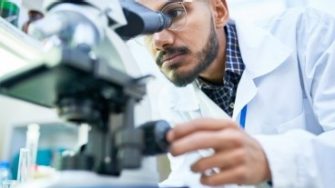
In 2024 we have continued to produce outstanding research across the spectrum of Optometry and Vision Science which has been recognised internationally.
Scientia Professor Fiona Stapleton was awarded the prestigious Ruben Medal from the International Society for Contact Lens Research at its meeting in August 2024. This medal recognises Fiona’s immense research contribution to the field of Optometry and Vision Science, especially her research on the epidemiology of contact lens-related infections and dry eye. At the same meeting PhD student Md Abdullah Aziz was awarded the Hikaru Hamano Travel Fellowship for his research on combining atropine and contact lenses for myopia control.
Also in August 2024, Emeritus Professor Eric Papas was awarded the prestigious H Barry Collin Research Medal for his exceptional achievements and significant contributions in cornea and contact lens research. Dr Daisy Shu received not one but two prestigious awards from the American Society for Investigative Pathology. She was awarded the Young Investigator Leadership Award, as well as the Dani and Erik Zander Junior Faculty Scholar Award.
Several of our researchers are in the Stanford/Elsevier's Top 2% Scientist Rankings, Prof Mark Willcox, Prof Konrad Pesudovs, Prof Fiona Stapleton, Prof Eric Papas, Prof Helen Swarbrick, as well as Prof Padmaja Sankaridurg and Prof Michael Kalloniatis. Our visiting academics, Prof Penny Asbell, Prof Lyndon Jones, Prof Philip Morgan, Prof Kovin Naidoo, and Prof Serge Resnikoff also feature in this list.
Grants
We performed well is every category of grant funding in 2024 – Category 1 (NHMRC, ARC grants), Category 2 (Other Public Sector Research Income) and Category 3 (private sector, philanthropic and international sources). Just to mention a couple:
Dr Daisy Shu was awarded a Category 1 Mito Foundation / Incubator Grant to study mitochondrial function in a stem-cell model of Leber’s Hereditary Optic Neuropathy.
Prof Mark Willcox was awarded a Category 3 grant to study a new contact lens disinfecting solution.
The Eye Research Group under A/Prof Jacqueline Tan-Showyin’s leadership received several industry grants to conduct clinical trials to develop potential new treatments for dry eye, including a novel formulation for those with autoimmune disease.
Publications
We had 63 journal papers in the top 10 percentile in 2024, with a total of 243 peer reviewed journal articles published. Our most highly cited paper in 2024 was a massive world-wide systematic analysis for the Global Burden of Disease (Konrad Pesudovs as an author, Published in The Lancet; https://doi.org/10.1016/S0140-6736(24)00757-8); for laboratory-based research it was by PhD student Binod Rayamahjee and his supervisors on Acanthamoeba (https://journals.plos.org/plosntds/article?id=10.1371/journal.pntd.0011878) and for clinic-based research it was by A/Prof Maria Markoulii, Emeritus Prof Eric Papas, and A/Prof Nicole Carnt and others on Presbyopia (https://doi.org/10.1016/j.clae.2024.102158).
Here is a selection of other papers that were published in 2024:
- Trinh M, Cheung R, Duong A, et al. OCT Prognostic Biomarkers for Progression to Late Age-related Macular Degeneration: A Systematic Review and Meta-analysis. Ophthalmology Retina. 2024; 8: 553-565. https://doi.org/10.1016/j.oret.2023.12.006
- Phu J, Tan J, Kalloniatis M. Multiple (frontloaded) visual field tests increase identification of very slow mean deviation progression in glaucoma. Canadian Journal of Ophthalmology. 2024; 59: 311-323. https://doi.org/10.1016/j.jcjo.2023.07.02
- Oberstein SL, Boon MY, Chu BS, et al. Does using a bioptic telescope improve visual recognition of the on-road environment? Optometry and Vision Science 2024; 101: 417-423. https://doi.org/10.1097/OPX.0000000000002138
- Maulvi FA, Parmar MB, Shetty K-H. Role of micelle dynamics in enhancing cyclosporine uptake in hyaluronic acid-contact lenses for improved critical lens properties in dry eye management. Colloids and Surfaces A: Physicochemical and Engineering Aspects. 2024; 688: 133550. https://doi.org/10.1016/j.colsurfa.2024.133550
- Webber AL, Toomey M, Keay L, et al. Building and maintaining interprofessional collaborative practice in eyecare: Learnings from the Queensland Paediatric Optometry Alignment Program. 2024; 44: 52-70. https://doi.org/10.1111/opo.13246
- Jia T, Tilia D, Papas E, et al. Comparison of vision performance of spectacles prescribed to 0.05D versus 0.25D steps. Clinical and Experimental Optometry, 107:1, 66-74. https://doi.org/10.1080/08164622.2023.2202305



